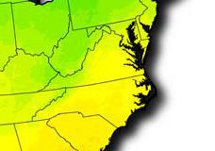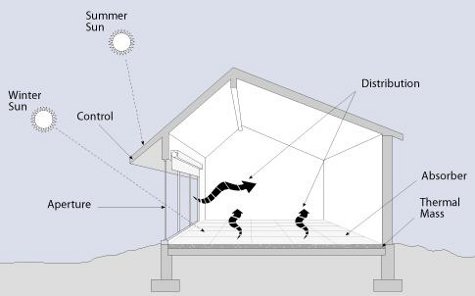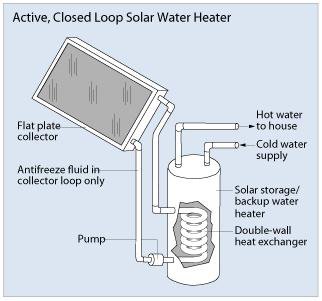Virginia has great solar potential– ranked 22nd of the 50 states, Virginia has more solar potential than New Jersey, the East Coast photovoltaic (PV) leader.
Virginia Has Potential

Ranked 22nd of the 50 states, Virginia has more solar potential
than New Jersey, the East Coast photovoltaic (PV) leader.
See the full NREL map.
Capitalizing on free solar energy is a great way to reduce your utility bill and do something positive for the environment.
There are three types of solar energy that you might be able to take advantage of in your home:
- passive solar
- photovoltaic (PV)
- solar thermal.
Passive Solar

Whether you are building a new home or remodeling your current home,
passive solar makes good design sense.
Read more about passive solar from EnergySavers.gov.
Passive or climatic design refers to geographical orientation and materials that take advantage of natural solar energy movement in air and matter. Your home’s windows, walls, and floors can be designed to collect, store, and distribute solar energy in the form of heat in the winter and reject solar heat in the summer. Passive systems are simple, have few moving parts, and require little or no maintenance.
The five elements of passive design are:
- The aperture or collector through which solar energy enters the building.
- An absorber that is hit by the sunlight and absorbs the radiation as heat.
- Thermal mass, such as stone or water, to hold onto the heat once it is absorbed.
- A method of distribution by which solar heat circulates from the collection and storage points to different areas of the house.
- Controls to adjust the amount of solar energy entering the house at different times of the year, such as roof overhangs or shades.
Photovoltaics (PV)
Photovoltaics rely on the capability of semiconductor materials to convert solar energy into electricity. Solar cells, the most basic PV building block can be combined into modules and modules can be combined into arrays.
The simplest PV arrays consist of flat-plate PV panels in a fixed position. Fixed arrays lack moving parts and are relatively lightweight, making them suitable for many locations, including most residential roofs. A PV system can include electrical connections, mounting hardware, power-conditioning equipment, and batteries.
There are many benefits to owning a PV system: it does less damage to the environment than fossil fuel energy sources, is easy to maintain, can be expanded if your power demand increases, and can be great long-term investments when combined with federal and state tax incentives.
Follow this link for more information about residential PV options and tools to help you figure out if solar is right for you.
Solar Thermal (Solar Hot Water)
Solar Thermal systems produce domestic hot water by utilizing a collector to warm either water or a water-antifreeze mix. In Direct Circulation Systems, household water heated within the collector is used directly in the home. However, in climates where freezing frequently occurs, it is better to use Indirect Circulating Systems. In these systems, the antifreeze fluid helps preheat your domestic hot water so that your water heater doesn’t have to do as much work.
There are three types of solar collectors that are appropriate for residential systems:
- Flat-plate– contains a dark absorber plate in either a glazed, weather-proofed box or without an enclosure.
- Integral collector-storage– system in which water is preheated as it flows through black tanks or tubes.
- Evacuated Tube– consists of parallel rows of glass tubes, each containing a metal absorber tube.
For more information about different solar thermal systems, and how to select and install a system, visit EnergySavers.gov.
More Information
Follow this link for more information about residential solar options and tools to help you figure out if solar is right for you.
Also see our list of some local solar providers.

